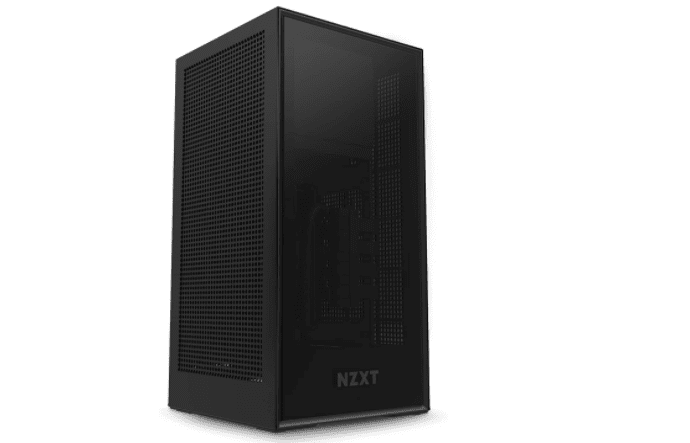NZXT H1 V2: This is an all-new NZXT H1 that provides a beautifully small vertical chassis, maintaining full-sized GPU compatibility. The building experience is streamlined, with pre-routed cable channels and an integrated PSU and AIO liquid cooler. The dual-chamber exhaust layout maintains superior cooling for the CPU and GPU, providing each with a dedicated air source.
The NZXT H1 was a unique compact PC case that made the H210 look like a large beast. Unfortunately for NZXT, the PCIe riser cable was not designed and manufactured to a safe standard, which eventually caused a fire-related recall. The company released a revised version of the PCIe riser cable for case owners and has made numerous improvements to the H1 to bring it up to standard in 2022 with the NZXT H1 V2.
There is a new PCIe riser cable, power supply, as well as enlarged dimensions so you can install even the best graphics card. 
NZXT H1 V2 Price
The NZXT H1 cost $350 with an AIO and PSU. It’s the same with the H1 V2, but with all the improvements included, as well as a better PSU, NZXT has bumped the price up to $400. All you need to add is a motherboard, processor, RAM, and a GPU (optionally). This is not the case for you if you are wanting to build a compact budget-friendly PC. It would be a better move to choose another small form factor case like the excellent NZXT H210i.
You may also like The Best Graphics Cards
NZXT H1 V2 features and Look
The front panel of NZXT H1 is tempered glass, that allows you to peek inside at installed components. The two sides have numerous larger perforated holes and have dust filters to pull in cool, clean air. The rear has the same hole array and is used as the sole exhaust. It’s a good design, that allows the CPU AIO cooler on the left and GPU on the right to get direct access to air in such a tight space.
But this meant the NZXT decided to use a PCIe riser cable for the GPU, which has been an issue not only for the company and the H1 but also for other brands with other cases. The H1 V2 comes with a revised design for the riser and should run just fine, though this should have been shipped with the original. Coming from the NZXT H1, it’s easy to notice the larger internal space for beefy graphics cards.
It comes with a 750W, 80 Plus Gold-rated power supply and 140mm AIO preinstalled, which is what help bump the price up considerably. This does allow one to focus on installing the motherboard and GPU without having to worry about choosing a PSU and working on cable management.
Design and Component Integration
The compact vertical design provides a small spatial footprint while maintaining support for most full-sized GPUs on the market so you can maintain your desk real estate without sacrificing graphics power.
The toolless SSD tray and riser card are incredibly simple to install. In addition to pre-routed cables, the motherboard I/O faces down, routing all cables through the bottom of the case for a clean, simplified appearance.
Integrated power supply and AIO liquid cooler provide a better build experience, along with pre-routed cables that make it easy to manage the clutter and cut down on build time. An integrated PCIe Riser card is also included for vertical GPU mounting.
Motherboard: Mini-ITX
I/O: 1x USB-C 3.1 Gen 2, 2x USB-A 3.1 Gen 1, 1x Headset Audio Jack
Expansion: 2 horizontal PCI
Storage: 2x 2.5-inch SSD
PSU: SFX (750W Gold included)
Side fans: 1x 140mm
Rear fan: 1x 120mm
Side rad: 140mm
Filters: Sides
Clearance: GPU 324mm
Dimensions: 15.9 x 7.7 x 7.7 inches (405mm x 196mm x 196mm)
An additional fan was installed to help direct air through the enlarged chassis. We didn’t have an issue with heat when running an AMD Ryzen 9 3900X in the first version of the H1, but the better thermal performance is always a good improvement. This added internal volume even allowed NZXT to install a fan controller, which can be managed by NZXT CAM software.
It’s the same great case that’s easier to build a PC inside, with most of the major original complaints addressed. We installed a system with an Intel Core i5-12600K processor, DDR5 RAM, and an RTX 3060 Ti GPU. This is a mid-range build that would be ideal for a chassis like the NZXT H1 V2.
Temperatures were great for this mid-range 12th Gen Intel processor. At idle, the 12600K sits comfortably at 35 C (95 F), gaming takes it up to 47 C (117 F) and stress tests pushed the CPU to 56 C (133 F).
NZXT H1 V2 Alternatives
There was not much competition when the NZXT H1 was released in 2020, but companies have joined NZXT by launching similar PC cases. iBUYPOWER is probably the closest competition for the NZXT H1 V2 with the HYTE Revolt 3. The Revolt 3 is far more affordable but doesn’t come with a PSU or AIO cooler.
HYTE opted to go with a direct contact for the GPU and motherboard negating the need for a PCIe riser cable. NZXT continues to require one with the H1 V2, and we have seen reliability issues with these risers in a variety of PC cases. The Revolt 3 also has a carry handle and headphone holders. It largely comes down to which design you prefer but preferred the Revolt 3 if I had to choose a case for a compact gaming PC.
CamRojud may earn a certain commission on products purchased via our links, supporting our effort on this content.
Would you like to read more about PC case-related articles? If so, we invite you to take a look at our other tech topics before you leave!










